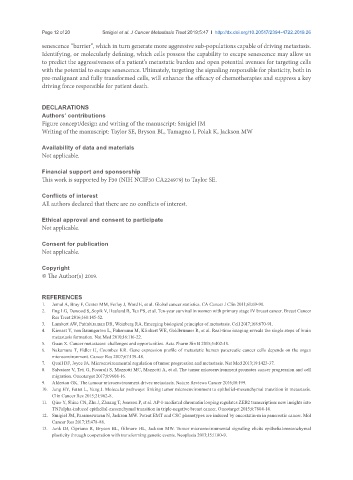Page 347 - Read Online
P. 347
Page 12 of 20 Smigiel et al. J Cancer Metastasis Treat 2019;5:47 I http://dx.doi.org/10.20517/2394-4722.2019.26
senescence “barrier”, which in turn generate more aggressive sub-populations capable of driving metastasis.
Identifying, or molecularly defining, which cells possess the capability to escape senescence may allow us
to predict the aggressiveness of a patient’s metastatic burden and open potential avenues for targeting cells
with the potential to escape senescence. Ultimately, targeting the signaling responsible for plasticity, both in
pre-malignant and fully transformed cells, will enhance the efficacy of chemotherapies and suppress a key
driving force responsible for patient death.
DECLARATIONS
Authors’ contributions
Figure concept/design and writing of the manuscript: Smigiel JM
Writing of the manuscript: Taylor SE, Bryson BL, Tamagno I, Polak K, Jackson MW
Availability of data and materials
Not applicable.
Financial support and sponsorship
This work is supported by F30 (NIH NCIF30 CA224979) to Taylor SE.
Conflicts of interest
All authors declared that there are no conflicts of interest.
Ethical approval and consent to participate
Not applicable.
Consent for publication
Not applicable.
Copyright
© The Author(s) 2019.
REFERENCES
1. Jemal A, Bray F, Center MM, Ferlay J, Ward E, et al. Global cancer statistics. CA Cancer J Clin 2011;61:69-90.
2. Eng LG, Dawood S, Sopik V, Haaland B, Tan PS, et al. Ten-year survival in women with primary stage IV breast cancer. Breast Cancer
Res Treat 2016;160:145-52.
3. Lambert AW, Pattabiraman DR, Weinberg RA. Emerging biological principles of metastasis. Cell 2017;168:670-91.
4. Kienast Y, von Baumgarten L, Fuhrmann M, Klinkert WE, Goldbrunner R, et al. Real-time imaging reveals the single steps of brain
metastasis formation. Nat Med 2010;16:116-22.
5. Guan X. Cancer metastases: challenges and opportunities. Acta Pharm Sin B 2015;5:402-18.
6. Nakamura T, Fidler IJ, Coombes KR. Gene expression profile of metastatic human pancreatic cancer cells depends on the organ
microenvironment. Cancer Res 2007;67:139-48.
7. Quail DF, Joyce JA. Microenvironmental regulation of tumor progression and metastasis. Nat Med 2013;19:1423-37.
8. Salvatore V, Teti G, Focaroli S, Mazzotti MC, Mazzotti A, et al. The tumor microenvironment promotes cancer progression and cell
migration. Oncotarget 2017;8:9608-16.
9. Alderton GK. The tumour microenvironment drives metastasis. Nature Reviews Cancer 2016;16:199.
10. Jung HY, Fattet L, Yang J. Molecular pathways: linking tumor microenvironment to epithelial-mesenchymal transition in metastasis.
Clin Cancer Res 2015;21:962-8.
11. Qiao Y, Shiue CN, Zhu J, Zhuang T, Jonsson P, et al. AP-1-mediated chromatin looping regulates ZEB2 transcription: new insights into
TNFalpha-induced epithelial-mesenchymal transition in triple-negative breast cancer. Oncotarget 2015;6:7804-14.
12. Smigiel JM, Parameswaran N, Jackson MW. Potent EMT and CSC phenotypes are induced by oncostatin-m in pancreatic cancer. Mol
Cancer Res 2017;15:478-88.
13. Junk DJ, Cipriano R, Bryson BL, Gilmore HL, Jackson MW. Tumor microenvironmental signaling elicits epithelial-mesenchymal
plasticity through cooperation with transforming genetic events. Neoplasia 2013;15:1100-9.

